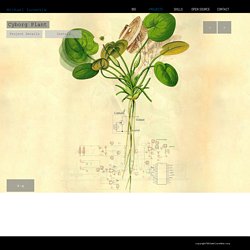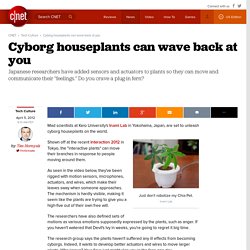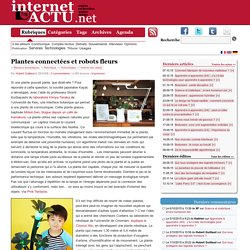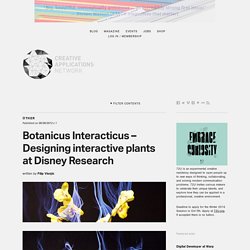

Scientists produce bionic plants using nanotubes to boost photosynthesis. MIT scientists have managed to create "bionic plants" with supercharged photosynthetic abilities.

The "cyborg" plants were created using nanotubes. (Photo : Bryce Vickmark/ MIT) Cyborg plants have taken over a laboratory in the Massachusetts Institute of Technology. Thankfully, the nanotube equipped plants are not hostile and the scientists who made them simply gifted the plants with a turbocharged capacity for photosynthesis. While the new development sounds like something pulled straight out of a science fiction novel, the practical applications of these "bionic plants" are both numerous and infinitely useful for humanity. Cyborg Plant. Born out my thesis, Flora Machina, the cyborg plant is the physical manifestation of theories and ideas that examine a landscape connected intimately with sensory technology.

The cyborg plant is a living Jade Plant inserted into a clear enclosure that houses several sensors, a processor and speakers. Once connected to a computer, the sensors feed information from the plant and the environment and are transcribed into an audio expression. Cyborg Baby Spinach Could One Day Detect Chemical Weapons. "I like to think/(right now, please!)

/of a cybernetic forest/filled with pines and electronics/ where deer stroll peacefully/past computers/as if they were flowers/with spinning blossoms," poet Richard Brautigan wrote in 1967. His heavily optimistic (or heavily satirical) take on cyborg plants was prescient. Now, half a century later, researchers are working on giving baby spinach bomb-detecting capabilities.
That’s right. Cyborg baby spinach. Researchers showed that the carbon nanotubes—tiny cylinders of carbon a thousand times thinner than a human hair—could slip into the chloroplasts without damaging them, and then actually give the chloroplasts a 30% boost in their ability to capture solar energy. Cyborg houseplants can wave back at you. Mad scientists at Keio University's Inami Lab in Yokohama, Japan, are set to unleash cyborg houseplants on the world.

Shown off at the recent Interaction 2012 in Tokyo, the "interactive plants" can move their branches in response to people moving around them. As seen in the video below, they've been rigged with motion sensors, microphones, actuators, and wires, which make their leaves sway when someone approaches. The mechanism is hardly visible, making it seem like the plants are trying to give you a high-five out of their own free will. The researchers have also defined sets of motions as various emotions supposedly expressed by the plants, such as anger. Gilbert Esparza's Cyborg Plant. Give your plant a voice with the PlantLink Sensor. Plantoid : des robots inspirés des plantes. ARBRE.

Tableau : Automatic House Plant Watering Tray by Pikaplant. The Internet of Vegetables: How Cyborg Plants Can Monitor Our World. In the not too distant future, we could see cyborg plants that tell us when they need more water, what chemicals they’ve been exposed to, and what parasites are eating their roots.

These part-organic, part-electronic creations may even tell us how much pollution is in the air. And yes, they’ll plug into the network. That’s right: We’re on our way to the Internet of Plants. That’s the message from Andrea Vitaletti, the head of a blue-sky research group working on this very thing at a lab in Italy. The project is called PLEASED, short for “PLants Employed As SEnsing Devices.”
“Plants have millions of years of evolution. ‘Plants have millions of years of evolution. . — Andrea Vitaletti His interest in combining plants and electronics dates to childhood, when he and his father used schematics found in an electronics magazine to build a simple circuit for generating sound from plants. Yes, we already have a wide variety of sensors for detecting temperature, humidity and the like. Pleased Vision.
Ganymède, la qualité de l’air au coin de la rue (3/5) Quatre étudiants ont mis au point un capteur connecté en forme de plante qui mesure le taux de pollution.

Plantes connectées et robots fleurs. Par Hubert Guillaud le 28/10/08 | 2 commentaires | 4,450 lectures | Impression Si une plante pouvait parler, que dirait-elle ?

Pour répondre à cette question, la société japonaise Kayac a développé, avec l’aide du professeur Stoshi Kuribayashi du laboratoire Hiroya Tanaka de l’université de Keio, une interface botanique qui permet à une plante de communiquer. Cette plante grasse, baptisée Midori-San, blogue depuis un café de Kamakura. Flower Power - Capteur intelligent pour vos plantes. Botanicus Interacticus - Designing interactive plants at Disney Research. Botanicus Interacticus is the tatest project created at Disney Research by Ivan Poupyrev in collaboration with Philipp Schoessler, Jonas Loh/Studio NAND, and Munehiko Sato.

The project is concerned with developing technology for designing “highly expressive interactive plants”, both living and artificial. Driven by the rapid fusion of computing and living spaces, the team take interaction from computing devices and places it in the physical world using livings plants as an interactive medium. Botanicus Interacticus has a number of unique properties. This instrumentation of living plants is simple, non-invasive, and does not damage the plants: it requires only a single wire placed anywhere in the plant soil. Plantoid, des racines robotisées pour simuler la croissance des plantes. Les technologies mises en œuvre dans le cadre du projet Plantoid pourraient faire progresser les outils environnementaux pour la surveillance des sols, mais également apporter des innovations dans les domaines médical et spatial avec le développement de capteurs et de matériaux inédits. © Projet Plantoid.

Top 5 des objets connectés pour vos plantes - Hydroponie.frHydroponie.fr. Les objets connectés prennent une place toujours plus importante dans nos vies et ce n’est qu’un début. Il est déjà possible d’en trouver pour satisfaire à peu près tous les besoins. Voici une sélection thématique consacrée aux amoureux du grand air et du jardinage. Si vous n’avez pas de jardin, pas de panique, des objets connectés pour plantes d’intérieur existent.